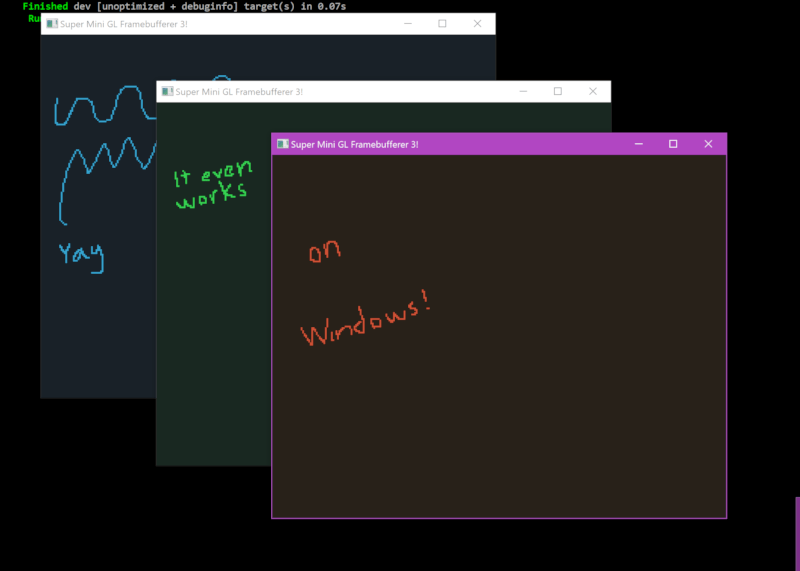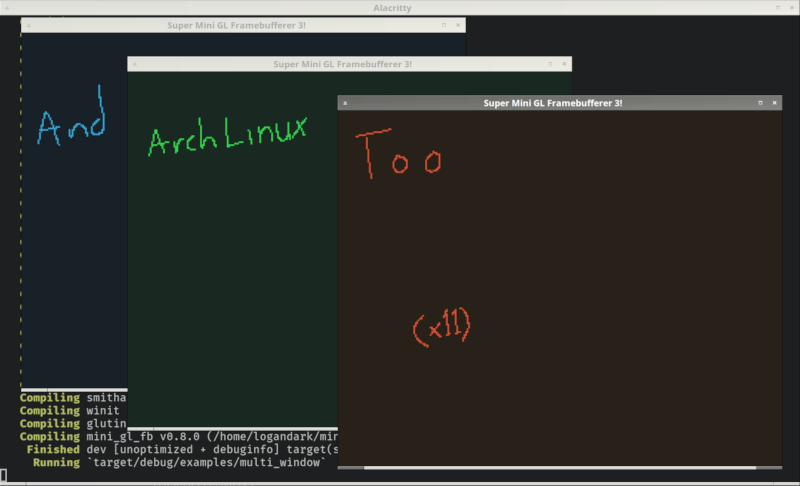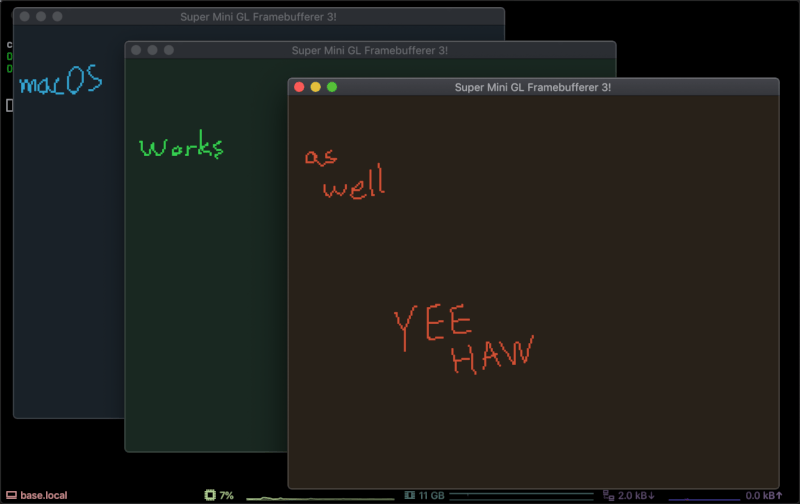10 releases (breaking)
| 0.9.0 | Jul 17, 2021 |
|---|---|
| 0.8.0 | Feb 22, 2021 |
| 0.7.0 | Apr 22, 2019 |
| 0.6.0 | Aug 25, 2018 |
| 0.2.4 | Jul 27, 2018 |
#98 in Rendering
Used in youxi
465KB
800 lines
Mini GL "Framebuffer" (MGlFb)
Mini GL Framebuffer provides an easy way to draw to a window from a pixel buffer. OpenGL
alternative to other easy framebuffer libraries like minifb and pixels.
It's designed to be dead simple and easy to remember when you just want to get something on the screen ASAP. It's also built to be super flexible and easy to grow out of in case your project gets serious. MGlFb exposes all of its internals so you can iteratively remove it as a dependency over time!
You can also use MiniGlFb::glutin_breakout to do rad things like multi-window while keeping
the useful Framebuffer helper around. There's an example called multi_window which shows
this in action.
MGlFb should run on any platform you throw it at, thanks to winit and glutin's
cross-platform compatibility. However, you do need proper GPU drivers which support OpenGL.
That means MGlFb won't work in certain virtual machines or on servers without a GPU.
Unfortunately, this isn't something that can be helped because MGlFb can't function without
OpenGL.
Screenies
Here are some screenies of the multi_window example running on different platforms:



It is a showcase of the advanced functionality that MGlFb can support, but it's not at all representative of how little work is required to get started.
Usage
extern crate mini_gl_fb;
fn main() {
let (mut event_loop, mut fb) = mini_gl_fb::gotta_go_fast("Hello world!", 800.0, 600.0);
let buffer = vec![[128u8, 0, 0, 255]; 800 * 600];
fb.update_buffer(&buffer);
fb.persist(&mut event_loop);
}
fb.update_buffer can be called as many times as you like and will redraw the screen each
time. You can bring your own timing mechanism, whether it's just sleep(ms) or something more
sophisticated.
Support for quick and easy, simple input handling
Get access to mouse position and key inputs with no hassle. The following is extracted from the Game of Life example:
use mini_gl_fb::glutin::event_loop::EventLoop;
use mini_gl_fb::Config;
let (mut event_loop, mut fb) = mini_gl_fb::gotta_go_fast("Hello, World!", 800., 600.);
let buffer = vec![[128u8, 0, 0, 255]; 800 * 600];
// ...
fb.glutin_handle_basic_input(&mut event_loop, |fb, input| {
let elapsed = previous.elapsed().unwrap();
let seconds = elapsed.as_secs() as f64 + elapsed.subsec_nanos() as f64 * 1e-9;
if input.key_is_down(VirtualKeyCode::Escape) {
return false;
}
if input.mouse_is_down(MouseButton::Left) {
// Mouse was pressed
let (x, y) = input.mouse_pos;
cells[y * WIDTH + x] = true;
fb.update_buffer(&cells);
// Give the user extra time to make something pretty each time they click
previous = SystemTime::now();
extra_delay = (extra_delay + 0.5).min(2.0);
}
// Each generation should stay on screen for half a second
if seconds > 0.5 + extra_delay {
previous = SystemTime::now();
calculate_neighbors(&mut cells, &mut neighbors);
make_some_babies(&mut cells, &mut neighbors);
fb.update_buffer(&cells);
extra_delay = 0.0;
} else if input.resized {
fb.redraw();
}
true
});
Shader playground
Post process with GLSL shaders inspired by ShaderToy. This is a work in progress but there is basic support for simple effects. The following is the default behavior but illustrates the API:
fb.use_post_process_shader("
void main_image( out vec4 r_frag_color, in vec2 v_uv ) {
r_frag_color = texture(u_buffer, v_uv);
}
");
Get full access to glutin/winit for custom event handling
You can also "breakout" and get access to the underlying glutin window while still having easy setup:
let (_, fb) = mini_gl_fb::gotta_go_fast("Hello world!", 800.0, 600.0);
let GlutinBreakout {
context,
mut fb,
} = fb.glutin_breakout();
fb.update_buffer(/*...*/);
The multi_window example works by running the winit event loop manually and handling events
for multiple GlutinBreakouts at once. You can do this too!
Other features
- Black and white rendering, specifying one byte per pixel
- Hardware accelerated buffer scaling (window and buffer can have different sizes)
- Exposes a function for creating a context with glutin in one line
- Exposes a function for creating a VAO, VBO, quad, and blank texture in one line
- If you don't want to use glutin you can bring your own context too!
See the docs for more info.
Planned Features (depends on demand)
Feel free to open an issue if you have a suggestion or want to see one of these soon!
-
More kinds of simplified input handling methods
-
Enhanced and more thorough shader playground
-
Support for running ShaderToy examples directly (a conversion function)
-
Support for more textures, possibly actual OpenGL framebuffers for complex sequences of post processing
-
An HTML canvas-like API that allows drawing over your buffer???
Dependencies
~4.5–6MB
~126K SLoC